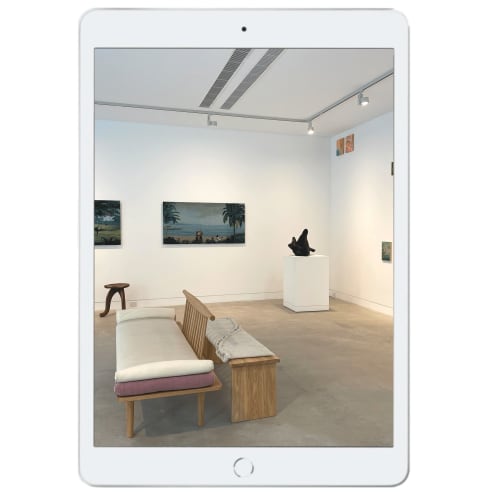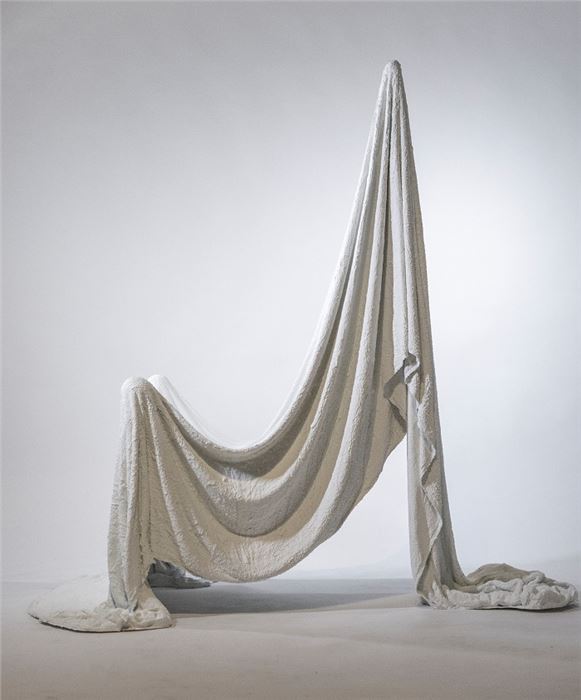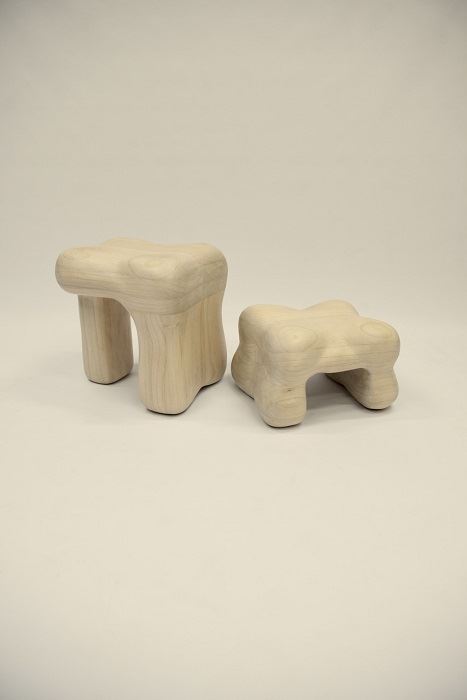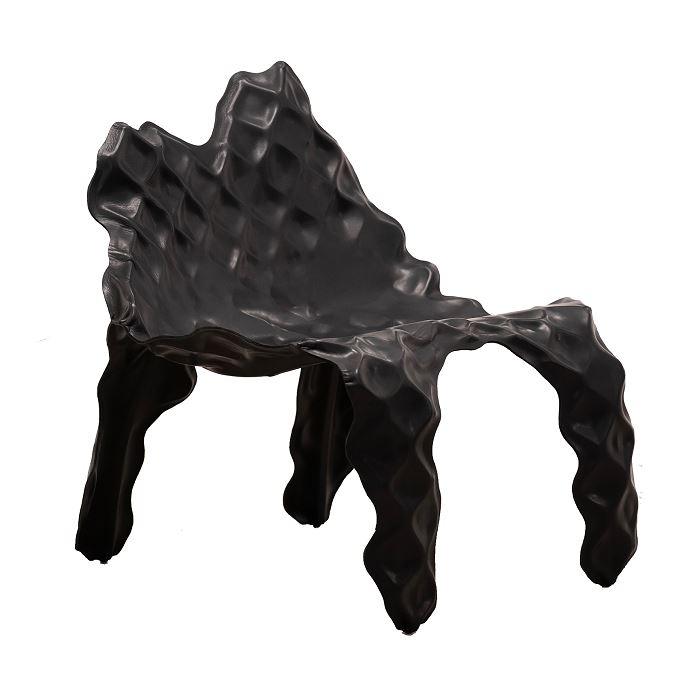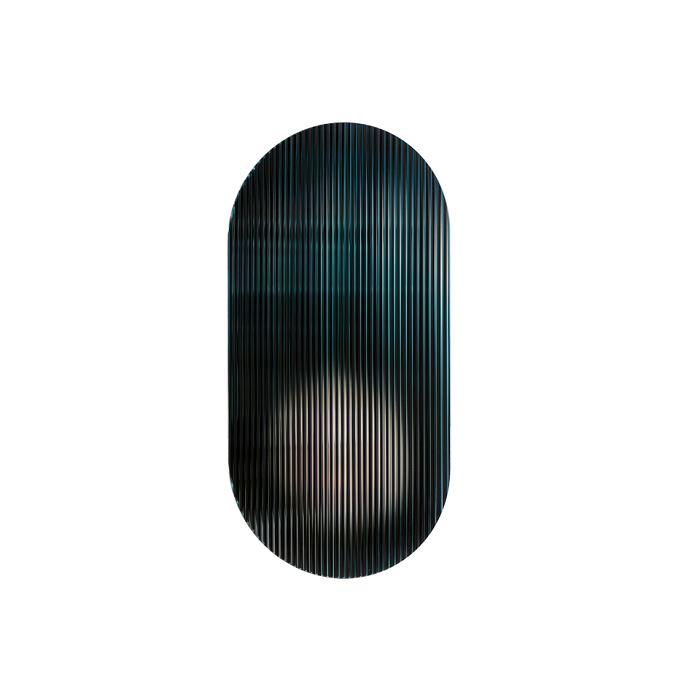Blurring the lines between fine art and design, diverse natural materials are used to create works that respond to a contemporary style of curation that seek both exploration and functionality.

Sabine Marcelis, Candy Cube Marshmallow (table), Polished, cast polyester resin/tempered steel, wax finish, 50 x 50 x 50 cm. Image courtesy of the Artist and Gallery Sally Dan-Cuthbert, Sydney.
In Sydney’s Rushcutters Bay, Gallery Sally Dan-Cuthbert is a space that brings together art and design — directed and curated by Sally Dan-Cuthbert, an art advisor for over 30 years, and former painting specialist at Christie’s. When she opened in August 2019, however, the curator redirected her attention to art that blurs the line of functional art into design.
Today, the gallery presents both fine artists and designers. Yet, the boundaries quite often merge. We have to double-check if we can sit or use the object, quite unlike a contemporary art piece. “Art collectors have through history often also been furniture collectors; it’s just that now it’s more in the ‘contemporary’ realm than in antiques,” shares Dan-Cuthbert. “Think Picasso plates and jugs or Giacometti furniture and lighting. Or Australian Marc Newson, a functional artist who set a record price with his Lockheed Lounge selling at Phillips in London for £2,434,500 in 2015.”
Andre Bahremand is one artist and designer whose work questions the scope of functionality. With a Master of Architecture from the University of Melbourne, in 2018, Bahremand moved to the Netherlands to work at architecture firm MVRDV. However, his time in Europe led the designer to refine his design sensitivity and he returned to Melbourne to explore furniture design.
Andre Bahremand, Layman's Throne, 2019, cement, plasticiser, Terry towel, approx. 152 x 80 x 130 cm. Image courtesy of the Artist and Gallery Sally Dan-Cuthbert, Sydney
The result of these investigations led to design pieces handmade from concrete, a popular modernist building material, yet careful and seemingly delicate, they explore the same questions as contemporary art. With each piece unique, almost ghost-like in appearance, Bahremand captures the shape of a chair as though under a sheet or blanket. The pull between comfort and discomfort negates the works, as does a sense of otherworldly design. “Layman’s Throne explores the structural capabilities of concrete and fabric and attempts to encapsulate the lightness and flow of the material whilst creating a functional piece of art,” the designer writes on his Instagram.
Using the medium of stainless steel, Gitting constructs fabrications of metal ecosystems that snake and curl through the frames of functional objects. “Future Ruins is a meditation on our place in nature and our relationship to the environment we seek to control, without ever fully seeking to comprehend either nature itself or the power it has over us,” the gallery adds.
Appearing as a returning theme, we see nature and return to form within the works of Perth-based artist and designer Olive Gill-Hille. With a Bachelor of Fine Arts from the Victorian College of the Arts, specializing in sculpture, art history takes a clear motif throughout her functional chairs and stools as she links design to contemporary narratives.
“During my bachelor of fine arts, I specialized in sculpture and spatial practice; at the time, I felt I hadn’t gotten a lot out of the degree as I didn’t have the skill set to make the sculptures I wanted to make,” Gill-Hille reveals. “Now I look back, and I realize, although I didn’t learn how to use the machinery and equipment I wanted to, it has helped me in thinking more abstractly and allowed me to apply conceptual and critical thinking to furniture and design.”
Olive Gill-Hille, Figure 1 and 2, 2018. Image courtesy of the Artist and Gallery Sally Dan-Cuthbert, Sydney
Gill-Hille’s designs are inspired by the human body, connecting soft, curved organic forms to physical touch, in a palette of natural stone and timber. “Within my practice, I’m attracted to organic shapes such as the forms of the human body and the way bodies have been represented in classical sculpture; I like adapting these shapes and remodeling them into functional pieces, making conventional artworks utilitarian,” the artist says.
Trent Jansen and Johnny Nargoodah, Ngumu Janka Warnti (All Made from Rubbish) Low Chair with Low Back, Black, 2020, New Zealand leather and aluminium, 80 x 65 x 75 cm. Image courtesy of the Artist and Gallery Sally Dan-Cuthbert, Sydney
Also inspired by nature, the collaborative duo Trent Jansen and Nyikina man Johnny Nargoodah use the natural material of leather to construct furniture that connects with the Australian environment. The pair first met during Fremantle Arts Centre’s exhibition, In Cahoots, resulting in The Jangarra Armchair. Now, the collaboration extends into an ongoing practice that is shown and collected by major Australian galleries such as the National Gallery of Victoria. The work reveals the authenticity of designers coming together to create furniture that readily serves as art; craftmanship at heart, and connection to country throughout.
Another artistic design collaboration, Rive Roshan by Golnar Roshan and Ruben de la Rive Box, explores the narratives of utopic art that connects their audiences. Their functional design pieces span artworks, design pieces, and installations. Using a dreamy palette of reflective materials, the works pull the viewer into their aura, expanding on ideas such as “shifting color through movement” and “observing time through movement.”
“We believe design is aimed at responding to a question or challenge often with practical objectives and a structured process. Art often offers a critical reflection on culture or life and influences the way we see the world around us,” the duo maintains. “Our aim is that of the artist, but our methodology is more akin to the designer.”
Rive Roshan, Colour Shift Panel, Indigo-Black, 2020, Fluted Coloured Reflective Panels, 120 x 60 cm. Image courtesy of the Artist and Gallery Sally Dan-Cuthbert, Sydney
Rive Roshan’s pieces balance theoretical concepts of unlocking the brain from stereotypes and generalizations to see new perspectives. Yet, as they reveal, this state of mind can be successfully captured through both art and design, blurring the boundaries and definitions that define the two practices. “A lot of our work does play with perception and what we call ‘visual wonder,’” they add. “We love to play with the way light travels through a material, or the sense of balance in an object. Your eyes see something that your brain doesn’t immediately understand.”
Furniture as art reveals that functional objects can hold a place within the contemporary art market as they investigate similar conceptual narratives. Modern design becomes highly collectable for an audience that curates spaces, rather than decorate. As Gallery Sally Dan Cuthbert concludes, functional art is ever popular — even more collectable through the pandemic as we reflect on individual spaces.
